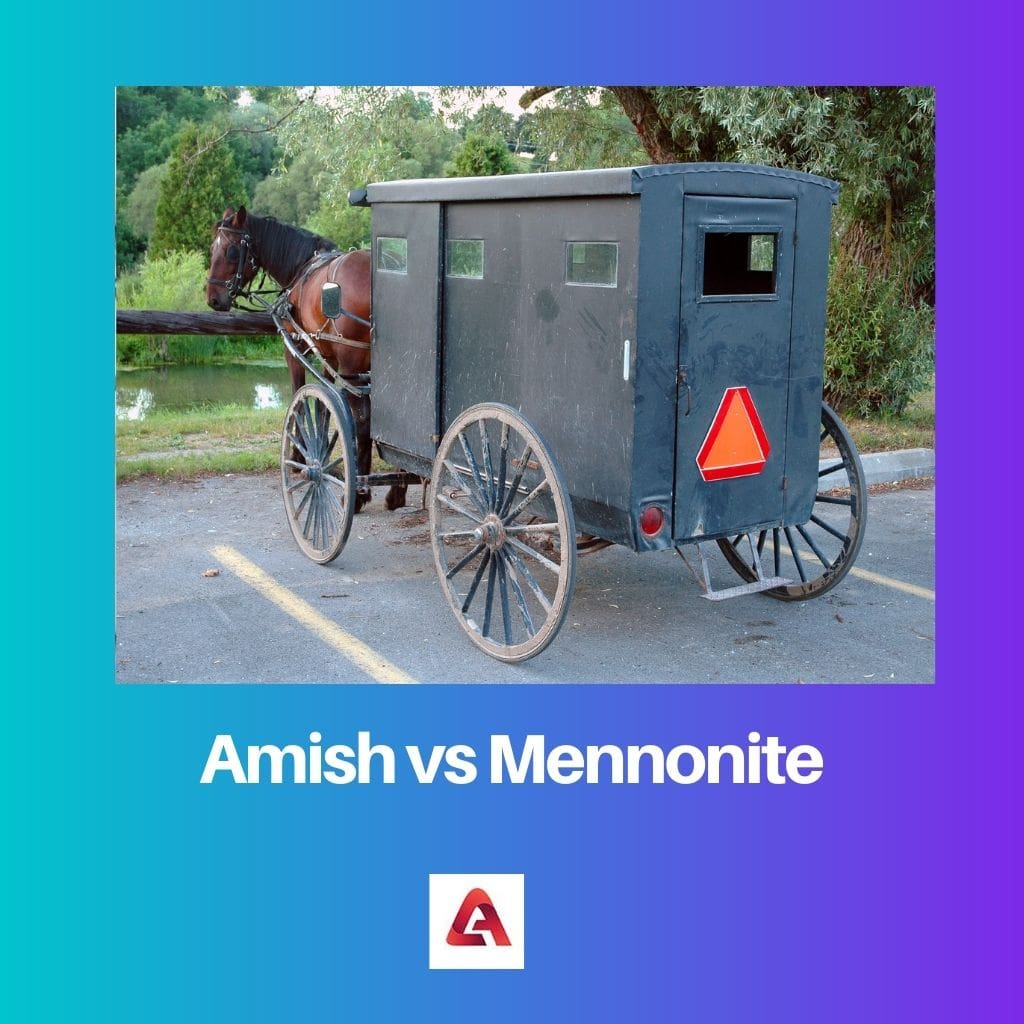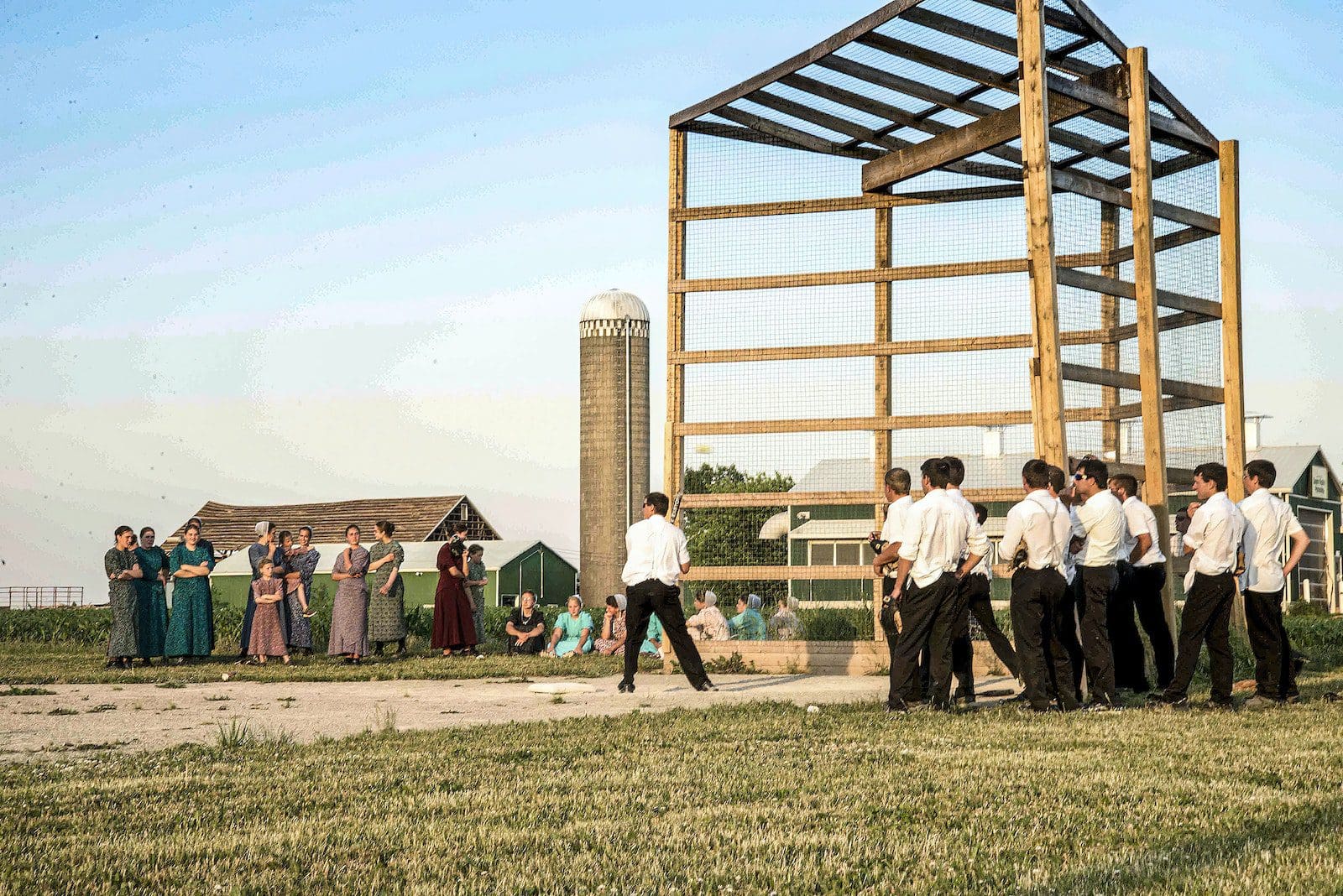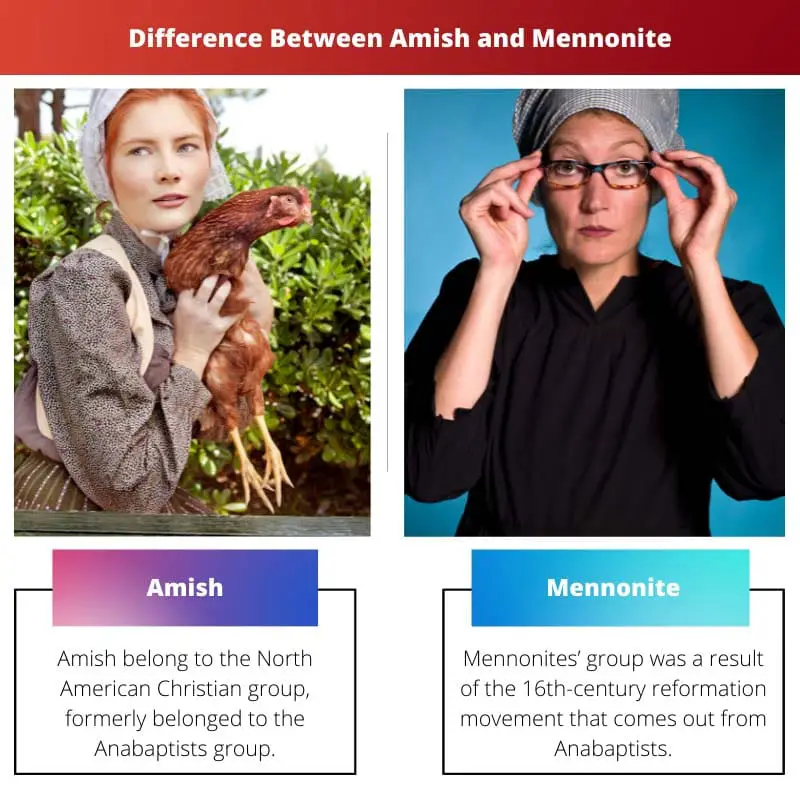Amish and Mennonite communities share Anabaptist roots but differ in their level of adherence to traditional practices. The Amish generally maintain stricter rules of separation from modern society, while Mennonites often integrate more with the outside world while still holding onto their faith and values.
Key Takeaways
- Both Amish and Mennonite are Christian denominations that originated in Europe.
- The Amish are a more conservative sect that emphasizes separation from modern society and the use of technology.
- The Mennonites are a more progressive sect emphasizing engagement with contemporary culture and social justice.
Difference Between Amish and Mennonite
Amish group was founded by Jakob Ammann, who believed that any sin needs severe punishment. Many people got attracted to this concept by Jacob Amann and started following it. In comparison, another group named Mennonites followed the same old peaceful practices of Anabaptists.

Amish follow the traditional and stringent practices of Anabaptists. They don’t get involved with other people worldwide and don’t believe in technology adoption.
They dress in very plain traditional clothes and travel in buggies or scooters.
Mennonites are known as a non-violent and flexible group of Anabaptists. They embrace and adopt the latest technology in their daily life. They are involved more in missionary work to help deprived people and spread their beliefs & faith across the world.
Comparison Table
| Feature | Amish | Mennonite |
|---|---|---|
| Origin | Split from the Mennonites in the late 1690s | Anabaptist movement in the 16th century |
| Separation from the World | Strict separation from modern society and technology. | Varying degrees of separation, with some embracing modern conveniences and others maintaining a simpler lifestyle. |
| Technology | Extremely limited use of technology. Electricity, cars, and most modern appliances are generally avoided. | More open to technology. Many use electricity, cars, and some modern appliances. |
| Clothing | Plain and simple clothing adhering to specific styles and colors. | Dress varies among different Mennonite groups, but generally more modern than Amish clothing. |
| Transportation | Horse-drawn buggies or bicycles. | Cars are common, along with bicycles and other forms of transportation. |
| Education | Typically limited to elementary education at home or in small, community schools. | Varying levels of education, with some pursuing higher education. |
| Missionary Work | Focus on their own communities, with limited missionary activity. | More emphasis on missionary work and spreading their faith around the world. |
| Church Service | Worship in homes or simple meetinghouses. | Worship in churches or meetinghouses. |
What is Amish?
The Amish are a religious group that originated from the Anabaptist movement in Europe during the 16th century. They are known for their distinct lifestyle, which emphasizes simplicity, humility, and community living.
History and Origins
The Amish trace their roots back to the Swiss Anabaptist movement led by Jakob Ammann in the late 17th century. Ammann’s followers became known as the Amish, after his name, and they faced persecution in Europe due to their beliefs, which included adult baptism, pacifism, and a rejection of modern conveniences.
Lifestyle and Beliefs
Amish life revolves around their faith, which guides every aspect of their daily activities. They live in close-knit agricultural communities, often referred to as settlements, where they work together, worship together, and support one another. The Amish adhere strictly to a set of religious guidelines known as the Ordnung, which governs everything from dress and appearance to technology use and social behavior.
Distinctive Practices
The Amish are known for their plain dress, which typically consists of simple, modest clothing in solid colors, without adornments like buttons or zippers. They also speak a German dialect known as Pennsylvania Dutch or Pennsylvania German and often use horse-drawn buggies for transportation, rejecting modern vehicles.
Education and Modernity
Amish children typically attend one-room schoolhouses run by the community until the eighth grade, where they learn basic academic subjects as well as practical skills like farming and homemaking. After completing their education, young Amish adults often participate in a period known as rumspringa, during which they can explore the outside world before deciding whether to join the church and commit to the Amish way of life permanently.
Community and Social Structure
Community is central to Amish life, and decisions are often made collectively by church leaders and members. They prioritize mutual aid and support, with members pitching in to help one another during times of need, such as barn raisings or emergencies. The church is the focal point of social life, where members gather for worship services, weddings, funerals, and other important events.
Challenges and Preservation
Despite their efforts to maintain a traditional way of life, the Amish face challenges from modernity, including encroachment on their land by urban development, pressure to adopt modern technology, and concerns about maintaining their cultural identity in an increasingly interconnected world.

What is Mennonite?
Mennonites are a Christian denomination that emerged during the Radical Reformation of the 16th century. They are named after Menno Simons, a Dutch Anabaptist leader who played a significant role in the movement’s development. Mennonites share some similarities with the Amish but also exhibit distinct characteristics and beliefs. Let’s delve into more detail:
History and Origins
The Mennonite movement began in the early 16th century in Europe, originating from the teachings of Menno Simons, along with other Anabaptist leaders like Conrad Grebel and Felix Manz. Like the Amish, Mennonites were persecuted for their beliefs, which included adult baptism, pacifism, and a commitment to communal living based on the teachings of Jesus Christ.
Diversity and Variations
Mennonites today are a diverse group, with different branches and practices influenced by factors such as geography, culture, and historical context. There are conservative groups that maintain traditional practices similar to the Amish, as well as more liberal branches that have integrated more with modern society. Some Mennonites have embraced urban living and professional careers, while others continue to prioritize rural agriculture and community-based lifestyles.
Core Beliefs and Values
Mennonites adhere to a set of core principles grounded in their interpretation of the Bible, including nonviolence, simplicity, and service to others. They emphasize the importance of living out their faith through acts of compassion, justice, and reconciliation in the world. Mennonites also place a strong emphasis on community and mutual aid, supporting one another through shared resources and assistance in times of need.
Engagement with Society
While some Mennonite communities maintain a degree of separation from the wider society, others actively engage with social and political issues, advocating for peace, justice, and environmental stewardship. Mennonite organizations are involved in various humanitarian efforts, including disaster relief, development projects, and refugee assistance. Many Mennonites also participate in interfaith dialogue and collaborative initiatives with other Christian denominations and religious traditions.
Education and Leadership
Education is highly valued within Mennonite communities, with an emphasis on both academic learning and practical skills development. Mennonite schools and colleges provide education at all levels, from elementary to graduate studies, often emphasizing peace studies, theology, and community development. Leadership within Mennonite congregations is typically decentralized, with decisions made collectively by church members and guided by the principles of consensus and mutual accountability.
Contemporary Challenges and Adaptation
Mennonites, like many religious groups, face challenges in the modern world, including questions of identity, declining membership in some regions, and tensions between traditional and progressive interpretations of faith. However, many Mennonite communities are resilient and adaptive, finding ways to navigate these challenges while remaining rooted in their core values and beliefs.

Main Differences Between Amish and Mennonite
- Adherence to Tradition:
- Amish: Maintain stricter adherence to traditional practices, often living in more isolated communities and resisting modern technology and conveniences.
- Mennonite: Exhibit greater variation in adherence to tradition, with some communities embracing modernity to varying degrees while still holding onto core beliefs.
- Approach to Technology and Lifestyle:
- Amish: Generally reject modern technology such as electricity and automobiles, preferring horse-drawn buggies and manual labor.
- Mennonite: Embrace a wider range of technology and lifestyle choices, with some communities integrating modern conveniences into their daily lives while others maintain a simpler, more traditional way of living.
- Engagement with Society:
- Amish: Tend to maintain a greater degree of separation from mainstream society, focusing on internal community life and avoiding outside influences.
- Mennonite: Often more engaged with society, participating in various social, political, and humanitarian efforts while still maintaining their distinct identity and values.

- https://www.etown.edu/centers/young-center/files/hmorton-references/Pediatric%20Medicine%20and%20Genetics%202003.pdf
- https://repository.lboro.ac.uk/articles/Physical_activity_profile_of_old_order_Amish_Mennonite_and_contemporary_children/9626393/files/17275031.pdf

The strict lifestyle of the Amish and the more flexible approach of the Mennonites provide an interesting contrast. It’s a testament to the diversity within Christianity.
Yes, it’s a reminder that there’s no one-size-fits-all approach to faith, and diversity of practice is a strength.
It’s fascinating to see the differences in beliefs and practices between the Amish and the Mennonites. Their dedication to their respective lifestyles is truly admirable.
Absolutely, the commitment to their faith and traditions is something to be respected.
I find their way of life intriguing and it’s interesting to learn about their core beliefs and values.
The strict adherence to traditional values by the Amish and the progressive approach of the Mennonites showcase the diverse expressions of Christianity. It’s a testament to the richness of religious traditions.
Absolutely, the different approaches to faith and tradition by the Amish and Mennonites provide valuable insights into the multifaceted nature of religious beliefs.
The diversity of practices within Christianity is truly fascinating. It’s a reminder of the complexity and depth of religious traditions.
The differences in the usage of technology between Amish and Mennonites show how faith can shape everyday life. It’s thought-provoking to consider this intersection.
Definitely, it’s fascinating to see how their religious beliefs translate into their practical choices in the modern world.
The commitment to humility and simplicity in the Amish way of life is truly remarkable. It’s a valuable example of living with purpose and conviction.
The Mennonites’ emphasis on missionary work and outreach efforts reflects a deep commitment to their faith. It’s an inspiring aspect of their religious practice.
The dedication of Amish and Mennonites to their religious practices is impressive. It’s a testament to the strength of their faith and tradition.
Absolutely, their commitment to their beliefs sets a powerful example of faith in action.
Their unwavering dedication to their religious values is truly commendable. It’s a reflection of their deep convictions.
The strict adherence to traditional values and separation from modern society by the Amish is quite extreme, but it’s a unique way of life that deserves to be understood rather than judged.
I agree, their commitment to their beliefs is commendable, even if it’s different from mainstream society.
The Mennonites’ approach of embracing modernity while maintaining core values is intriguing. It’s a good example of finding a balance between tradition and progress.
Absolutely, it shows how their faith can adapt to changing times while still holding onto their fundamental beliefs.
The contrast between Amish and Mennonite beliefs highlights the nuances within Christianity. It’s a reminder that religious traditions can vary widely.
Absolutely, it’s important to recognize the diversity within Christianity and understand different interpretations and practices.
The unique practices of the Amish and Mennonites bring depth to the study of religious traditions. It’s enlightening to learn about their beliefs.